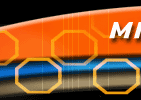




People and Microbes
Research the people who in the last 150 years have created the science of Microbiology.
Go to Microbiologists
Related Web Sites to investigate can be found on the links page.
Microbes in Industry
Investigate how microbes are used to manufacture things used in the home:
Examples:Related Web Sites to investigate can be found on the links page.
- Washing powders
- Food products
- Medicines
Microbiology at Our Service
How has microbiology contributed to the work of the police, farmers, doctors, food manufacturers, archaeologists and planetary scientist?
Related Web Sites to investigate can be found on the links page.
Food Preservation
Most food supplies on Space Station 2020, or on a human expedition to Mars, will be carried in a preserved form. There are many methods of food preservation and they have been around for a long time. Here are some:-
- Cooking
- Pickling
- Sugar-preserves
- Salting
- Smoking
- Drying
- Freezing
- Freeze-drying
- Irradiation
- Fermentation
- Distillation
- Vacuum-packing
- Canning
- Sun drying
- Traditional cheese and milk product manufacture
- Bean curd making
- Ohmic heating
- Pasteurization
- Refrigeration
- Synthetic chemical preservatives
- Heat sterilization
- how old they are,
- where they are thought to have originated
- what they do to preserve the food
- how they change the food
- why they work in avoiding or reducing fungal and bacterial attack
- how effective they are and how long they preserve the food
- say whether or not microbes (bacteria or fungi) are used in the preservation process and describe what they do.
Also, if your culture uses a particular means of preserving food that is not mentioned here, investigate it and describe the chemical and biological processes involved.
Would these have a place in space? Ask yourself, particularly, how well would they work in microgravity. Perhaps you have the basis for a new experiment for your national space agency.
Related Web Sites to investigate can be found on the links page.
Go to
Food Preparation on Space Station 2020
Menus for Different Nationalities
NASA's current menu has been designed for the American palate. Can you design a menu that would be suitable for astronauts from different countries?
Describe how you would store food and dispose of the waste. What health risks are there associated with food preparation and storage?
First, research the menus aboard the MIr Space Station, to see how the Russians approach the problems of eating in space, then design a menu for a Chinese, Japanese and French astronaut. Can the NASDA and ESA web sites help?
Now design a menu that would be acceptable to any nationality. Try and contact people your age in different countries to find out what they like to eat.
Related Web Sites to investigate can be found on the links page.
Go to Food Preparation on Space Station 2020
Detecting Life in Space I
Investigate the following NASA Missions and find out which includes, or included, life-detection experiments:-
- Magellan
- Galileo
- Voyager
- Viking
- Mars Polar Lander
- Mars Express/Beagle 2
- Deep Space 1
- Cassini/Huygens
Related Web Sites to investigate can be found on the
links page.
Detecting Life in Space II
Design your own robot mission to explore life in the Solar System. You will need to research your target to answer these questions:-
ConsiderYour mission must be scientifically feasible, using current technology. No "warp drives" please!
- Which planet, moon, asteroid or comet you would go to?
- How long would it take?
- What instruments would you send?
- The overall weight of the robot must be less than 10 tons.
- The cost of the mission should be thought about - will the public approve, who will fund it, and if it is the government, will they let you have the money?
Related Web Sites to investigate can be found on the links page.
Exercise 7
Yellow Fever in America
Yellow fever shaped the history of the United States in profound ways.
Investigate
how Yellow Fever and other diseases affected the early colonization of
North America.
What impact did Yellow Fever epidemics have on social development
and racial issues?
How was Yellow Fever beaten by US Army Medical Corp and
why did this shortened the trip from New York to Australia?
Related
Web Sites to investigate can be found on the links
page.
Exercise 8
Microbes in History
Throughout history disease has played a role in shaping man's destiny. Research one aspects of this and how it decided the course of future events.
Suggested areas of research:
- The Black Death
- Napoleon and his conquest of Europe
- The Panama Canal
- The colonization of America and Africa
- The development of inoculation and immunization
- Cholera and development of hygiene standards
Go to Diseases from the Tropics
Go to Yellow Fever in the Americas
Related Web Sites to investigate can be found on the links page.
Exercise 9
Polluting Space
As we turn our attention to the stars and send spacecraft to the planets, how important is it that we do not take our microbes with us. Discuss the scientific and ethical questions involved.
Related Web Sites to investigate can be found on the links page.
Microbiology
Index - The Search for Life in Space
Microbiology Index - Microbiology on Space Station
2020
Microbiology Index - Microbiology in the Rainforest
Go
to
Home
| Space Station
| Mars | Rainforest
© 1999 Satellite Events Enterprises Inc.